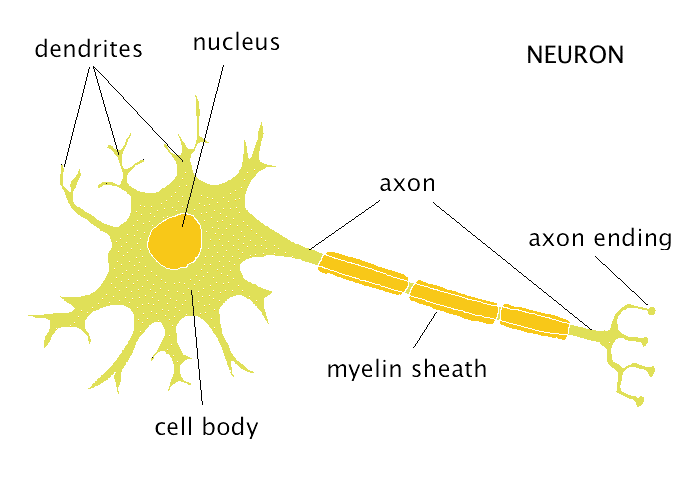An axon or nerve fiber is a long slender projection of a nerve cell or neuron that conducts electrical impulses away from the neuron’s body or soma. Axons are in effect the primary transmission lines of the nervous system and as bundles they help make up nerves. Dendrites on the other hand are projections of a neuron (Nerve cell) that receives signals (information) from other neurons. The transfer of information from one neuron to another is achieved through chemical signals and electric impulses, that is, electrochemical signals.
Below, learn more differences between axon and dendrite. The basis of comparison include: occurrence, vesicles, branches, synaptic knob, myelin sheath, diameter and presence of ribosomes, impulse transmission, origin, diameter, Nissl’s granules and more.

Key Differences
- Dendrite is a short branched extension of a nerve cell, along which impulses received from other cells at synapses are transmitted to the cell body whereas an axon is a long slender projection of neuron that conducts electrical impulses away from the neuron’s cell body or soma.
- Axons are long and single per cell while dendrites are short and multiple per cell.
- The synaptic knobs of the axons contain vesicles with neurotransmitters whereas; dendrites do not have vesicles that contain neurotransmitters.
- Axons have branches far away from the cell body, and these branches are present at terminal point or axon terminal of a neuron. On the other hand, dendrites have branches near the cell body, and these branches are present at the origin of the neuron.
- Dendrites receive electrochemical impulses from other neurons and carry them inwards and towards the cell body (cyton) while axons carry the impulses away from the cell body (cyton).
- The axon arises from a conical projection, the axon hillock, from the discharging end of neuron while dendrites arise directly from the nerve cell (surface of the neuron).
- The axon terminal branches are enlarged to form synaptic knobs at the tips known as end bulbs. On the contrary, no synaptic knobs occur at the tips of the branches of the dendrites.
- Axons can be either medullated or non-medulated while dendrites are usually non-myelinated (Non-medullated).
- Axons have a uniform diameter and do not have ribosomes on their surface. Dendrites on the other hand, have ribosomes with tapering ends; therefore, their diameter continuously decreases.
- Axons form the efferent component of the nerve impulse whereas, dendrite form the afferent component of the nerve impulse.
- Axons do not contain Nissl’s granules but they contain neurofibrils all over them. Dendrites on the contrary contain neurofibrils and Nissl’s granules.
- Axons are very long (above 50mm) while dendrites are very short (about 2.0 mm).
Also Read: Difference Between Myelinated and Unmyelinated Neurons
The Difference Between Axon and Dendrite In Tabular Form
| BASIS OF COMPARISON | AXON | DENDRITE |
| Description | An axon or nerve fiber is a long slender projection of a nerve cell or neuron that conducts electrical impulses away from the neuron’s body or soma. | Dendrites on the other hand are projections of a neuron (Nerve cell) that receives signals (information) from other neurons. |
| Occurrence | Axons are long and single per cell. | Dendrites are short and multiple per cell. |
| Vesicles | The synaptic knobs of the axons contain vesicles with neurotransmitters. | Dendrites do not have vesicles that contain neurotransmitters. |
| Branches | Axons have branches far away from the cell body, and these branches are present at terminal point or axon terminal of a neuron. | Dendrites have branches near the cell body, and these branches are present at the origin of the neuron. |
| Impulse Transmission | Axons carry the impulses away from the cell body (cyton). | Dendrites receive electrochemical impulses from other neurons and carry them inwards and towards the cell body (cyton). |
| Origin | The axon arises from a conical projection, the axon hillock, from the discharging end of neuron. | Dendrites arise directly from the nerve cell (surface of the neuron). |
| Synaptic Knob | The axon terminal branches are enlarged to form synaptic knobs at the tips known as end bulbs. | No synaptic knobs occur at the tips of the branches of the dendrites. |
| Myelin Sheath | Axons can be either medullated or non-medulated (have a myelin sheath). | Dendrites are usually non-myelinated (Non-medullated)/ (do not have myelin sheath). |
| Diameter and Presence of Ribosome. | Axons have a uniform diameter and do not have ribosomes on their surface. | Dendrites ribosome with tapering ends; therefore, their diameter continuously decreases. |
| Afferent/Efferent | Axons form the efferent component of the nerve impulse. | Dendrites form the afferent component of the nerve impulse. |
| Nissl’s Granules | Axons do not contain Nissl’s granules but they contain neurofibrils all over them. | Dendrites contain neurofibrils and Nissl’s granules. |
| Diameter | Axons are very long (above 50mm). | Dendrites are very short (about 2.0 mm). |
What Are Some Of The Similarities Between Axon And Dendrite?
- Dendrite and axon are both branched structures.
- Both dendrite and axon contain neurofibrils.
- Both can be regarded as projections of the cell body of a nerve cell.
- Both dendrite and axon transmit nerve impulses.
- Both are parts of neuron.